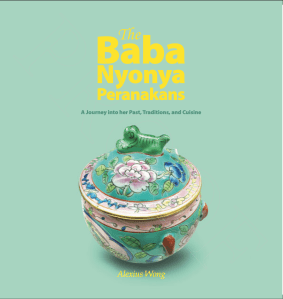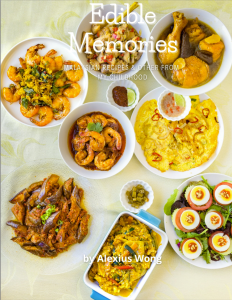
For many years, this dish was not a staple in my cooking repertoire as I grew up eating it only on rare occasions. It was more frequently cooked when my father and his siblings were being raised by their single mother. But while working on this recipe, I marveled at its simplicity on one hand and its profile of complex flavors on the other. Due to its simplicity and relatively quick cooking time, it was served at regular meals as well as for offerings during the anniversary of a death in which favorite dishes of the deceased were offered at the altar as a gesture to honor their loved ones.
Compared with most Nyonya dishes, this quick dish can be easily mastered by anyone. Despite the short list of ingredients, we see the Peranakan penchant for different layers of strong flavor. It is not enough for Peranakans to simply cook the chicken in plain soy sauce, since their palate always craves the heat of red chili peppers and other strongly flavored ingredients. The red onion adds a subtle sweetness that acts as the liaison between the salty soy sauce and the brightness of the lime juice. Serving it with the spicy and pungent condiment, sambal belacan, adds another dimension and complexity to the flavor profile, and is typically how it is eaten at the dinner table.
A posting of this recipe on social media received many reactions from people who shared memories of growing up eating it but have not relished it for many years. It also revealed to me that this cooking technique is not only reserved for chicken, as the posters commented that they enjoyed variations made with fried eggs, fish, eggplant, and even cripsy fried ikan bilis or dried Asian anchovies. It is indeed a versatile sauce that is highly favored among the Peranakans due to its many flavor elements.
Once you have tried this recipe, you may marvel at how wonderful and satisfying it is. It has become a weekly staple for me and also for some of my relatives who are always pinched for time in the kitchen. After a taste of this, you will understand why the Peranakans, both living and deceased, are so fond of this chicken recipe.
Recipe from The Baba Nyonya Peranakans book
Serves 4 to 6
Preparation time: 50 minutes
3 tablespoons vegetable oil
1 very large (400 grams/14 ounces) red onion, peeled and cut into medium-size vertical slices
2 Finger Hot red chili peppers, seeded and sliced not too finely, or 1 tablespoon Sambal Oelek
4 chicken thighs with drumsticks, or 8 drumsticks, cut into bite-size pieces
1½ teaspoons thick dark soy sauce
5 tablespoons thin soy sauce
1½ cups water
2 tablespoons lime juice
- In a pan on medium-high heat, heat the oil and cook the onion and chili until quite soft, about 4 minutes. Add the chicken pieces and cook for 5 minutes more until no longer pink. Add the dark and light soy sauces and the water. Reduce the heat to medium. Simmer with the lid of the pan ajar for 15 minutes, stirring every few minutes.
- Remove the lid, reduce the heat to medium-low, and cook for 15 minutes more while stirring occasionally, to let the sauce reduce—add a bit of water if it reduces too quickly. Taste and adjust the seasoning with light soy sauce. You may remove excess grease from the sauce.
- Add the lime juice just before serving and stir well. Serve with sambal belacan with lime juice added to it.
Sambal Belacan
6 grams/½ teaspoon belacan (shrimp paste), toasted and ground
6 Finger Hot red chili peppers, stemmed and seeded, or 2 tablespoons paste/sambal oelek
Salt
1 teaspoon lime juice, preferably from Kalamansi lime
- If using belacan paste, spoon it onto a piece of aluminum foil, fold it until well sealed, and bake in a toaster oven on 350°F for 5 minutes or until aromatic. If you are using a belacan square, toast it over an open fire until aromatic. Take it outside to cool and to keep the strong smell out of the house.
- In a food processor, purée the chilis with the belacan to a smooth paste. Add salt to taste.
- Serve by squeezing the lime juice into it.
If using wet shrimp paste and sambal oelek:
Put the shrimp paste in a bowl and squeeze a bit of lime juice on it. With the back of the spoon, press the paste into the juice until the mixture is well incorporated. Add the sambal oelek and mix well. Finish with more lime juice and mix well.


The hardcopy and e-book of The Baba Nyonya Peranakans book (1st image) and Edible Memories e-cookbook (2nd image) are available – more information on the Homepage.

I didn’t realize that it was so easy to cook this dish. Will introduce it to my family next week.
LikeLike
You will be surprised how tasty this simple dish is. Hope you enjoy it.
LikeLike
This dish is easy and simple. I think I can handle this. Thanks for sharing Alex. Greatly appreciated.
LikeLike
You are welcome. Hope you enjoy it when made.
LikeLike
Sounds easy! Definitely Will give a try!
LikeLike
Thank you. You will enjoy this!
LikeLike
Will try this tasty n simple dish. Thanks for sharing. I appreciate your recipient in blog
LikeLike
You are welcome. I hope you enjoy the results.
LikeLike
My mother would ask me to catch a selected chicken which was roaming around and chasing and catching it was quite exhausting not only for the chicken but particularly for me! But the effort was worth it, as she was superb at cooking the dish.
LikeLike
I can imagine you running around the Kampung chasing the chicken. But the reward must have been fulfilling with a dish like this.
LikeLike
Is the taste sourish as no sugar is added in this recipe?
LikeLike
The natural sugars will come from the huge amount of sweet onions.
LikeLike
Sounds lovely
Noted this recipe doesn’t use oyster sauce or sugar nor does it use kaffir leaves
Can I add kaffir leaves abit with the juice?
Or will that alter the dish? Thank you
LikeLike
Thanks for your inquiry. This dish has a simple flavor, but full, that is made of just the 4 elements of sweet, sour, spicy, and savory. In all my years of seeing the various versions, my recipe doesn’t stray from this flavor profile. Remember to serve it with Sambal Belacan with some lime juice. Hopefully you will enjoy this unique-flavored dish.
LikeLike
Was trying to subcribe your mini cookbook but cant get through
LikeLike
Please try this link and wait 24 hours before you receive it. Thank you.
https://yahoo.us20.list-manage.com/subscribe?u=9585b2a894925cd8701ab619f&id=bbb7632432
LikeLike